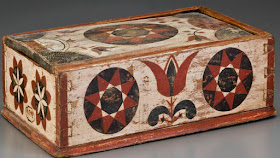Cotton Boll or Anthemion, classical imagery in quilt design
See a post about Anthemia here
From the Connecticut project & the Quilt Index
Laurel Wreath, a classical image signifying honor
and glory....
Napoleon
Self-appointed or not.
Typical floral image in Germanic colors, motifs and arrangement.
Pennsylvania German candle box dated 1792
Painted detail from a Pennsylvania chest about the same time
from the Barnes Collection
From a Baltimore album quilt, Woodard & Greenstein photo
Newspaper masthead from Baltimore in 1846
Detail of a quilt in the Sharon Newman collection at
the Rocky Mountain Quilt Museum
Some patterns became standards.
From the Kentucky project & the Quilt Index
While others seem one-of-a-kind, perhaps drawn from nature.
For the next few days we'll look at the influence of botanizing, a 19th-century
word for collecting and classifying plants, a popular women's hobby.














Oh this will be fun. Wild flowers especially draw me in.
ReplyDeleteWe lived in Texas for a while, around Austin and I loved the
wild flowers in abundance in the spring.
The Lady Bird Johnson Wild Flower Center is in Austin and
July 28 is a free admission day.
See how excited I get?
You'll like this series, Janie. May inspire you.
ReplyDeleteBarbara...thank you for imparting all this glorious information. Much appreciated. Blessings.
ReplyDeleteI collect photos of quilts featuring eagles. Many of them come right from your posts, so thanks!!!
ReplyDeleteI'd like to design a patriotic eagle quilt with elements from many that I see. They are so wonderful! Even the eagles with irons clutched in their talons from a couple of weeks ago!
Over the past few years, I have been sketching out ideas for a future floral quilt, so am looking forward to the coming posts.
ReplyDeleteI am so glad to see you use the term "Pennsylvania German". For decades I have tried to explain that the word "deutsch" mangled as "dutch" by English speakers in both South Africa and Northern America refers to Germany not Holland.
ReplyDelete